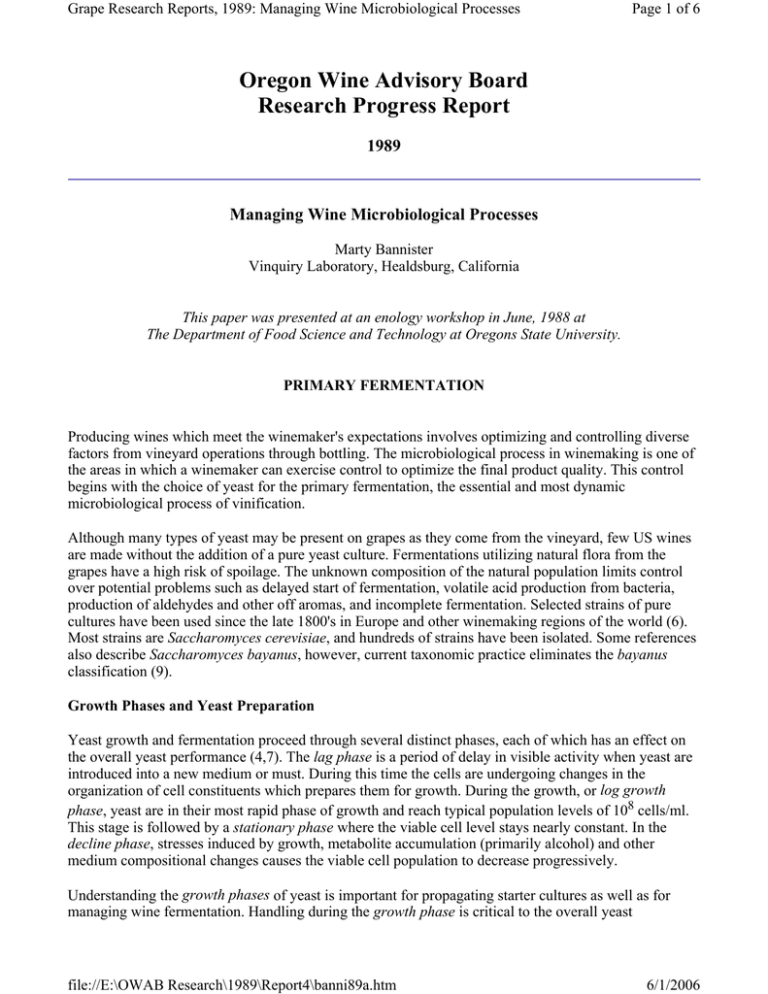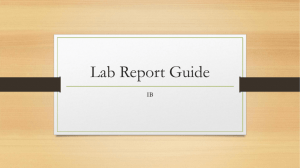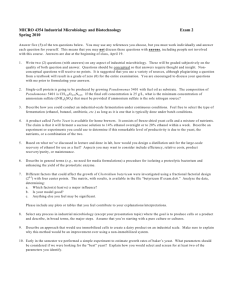Oregon Wine Advisory Board Research Progress Report 1989 Managing Wine Microbiological Processes
advertisement

Grape Research Reports, 1989: Managing Wine Microbiological Processes Page 1 of 6 Oregon Wine Advisory Board Research Progress Report 1989 Managing Wine Microbiological Processes Marty Bannister Vinquiry Laboratory, Healdsburg, California This paper was presented at an enology workshop in June, 1988 at The Department of Food Science and Technology at Oregons State University. PRIMARY FERMENTATION Producing wines which meet the winemaker's expectations involves optimizing and controlling diverse factors from vineyard operations through bottling. The microbiological process in winemaking is one of the areas in which a winemaker can exercise control to optimize the final product quality. This control begins with the choice of yeast for the primary fermentation, the essential and most dynamic microbiological process of vinification. Although many types of yeast may be present on grapes as they come from the vineyard, few US wines are made without the addition of a pure yeast culture. Fermentations utilizing natural flora from the grapes have a high risk of spoilage. The unknown composition of the natural population limits control over potential problems such as delayed start of fermentation, volatile acid production from bacteria, production of aldehydes and other off aromas, and incomplete fermentation. Selected strains of pure cultures have been used since the late 1800's in Europe and other winemaking regions of the world (6). Most strains are Saccharomyces cerevisiae, and hundreds of strains have been isolated. Some references also describe Saccharomyces bayanus, however, current taxonomic practice eliminates the bayanus classification (9). Growth Phases and Yeast Preparation Yeast growth and fermentation proceed through several distinct phases, each of which has an effect on the overall yeast performance (4,7). The lag phase is a period of delay in visible activity when yeast are introduced into a new medium or must. During this time the cells are undergoing changes in the organization of cell constituents which prepares them for growth. During the growth, or log growth phase, yeast are in their most rapid phase of growth and reach typical population levels of 108 cells/ml. This stage is followed by a stationary phase where the viable cell level stays nearly constant. In the decline phase, stresses induced by growth, metabolite accumulation (primarily alcohol) and other medium compositional changes causes the viable cell population to decrease progressively. Understanding the growth phases of yeast is important for propagating starter cultures as well as for managing wine fermentation. Handling during the growth phase is critical to the overall yeast file://E:\OWAB Research\1989\Report4\banni89a.htm 6/1/2006 Grape Research Reports, 1989: Managing Wine Microbiological Processes Page 2 of 6 performance. With each new cell generation, cell constituents are depleted. During vinification, the number of cell generations is four or five (7). Too low an inoculum may result in a longer lag phase, a low stationary population, and a shower fermentation. During growth, an adequate supply of nutrients for yeast uptake is critical for generating a population large enough and strong enough to complete the fermentation. Availability of oxygen during growth also plays a role in a healthy fermentation because yeast produce cellular sterols in the presence of oxygen. These sterols function as survival factors enabling yeast to withstand stressful conditions and to complete fermentation when the cells undergo depletion of cellular reserves during the decline phase (5,7). Proper preparation of the yeast prior to inoculation can also help avoid sluggish fermentations (4). With active dry yeast (ADY), careful attention to water temperature, time of rehydration, avoiding S02 during rehydration, and avoiding cold shock conditions is important to obtaining a maximum population. Winemakers have sometimes been given the impression that ADY can be sprinkled dry into a fermenter. This practice can result in high loss of viability due to leaching of cell materials and lethal intracellular doses of S02. Choice of Yeast and Yeast Nutrition Choice of strain can make a small but significant contribution to the character and style of a wine. Strains have differing abilities to tolerate alcohol, S02, sugar, cold, and heat. Some strains ferment more vigorously or may produce different levels of esters, H2S, aldehydes, and organic acids. Certain strains ferment to dryness with more reliability while others may be chosen because they are easier to stop with residual sugar remaining. Aroma and flavor differences may also result from controlling the yeast fermentation. For example, yeast which ferment under cold conditions will produce a wine with higher ester levels than at warmer temperatures. Strains used for wine fermentation are available as slant or liquid cultures or as active dry yeast (ADY). Recently more strains have become available as ADY. The active dry form offers many advantages, and generally speaking is the preferable form when available. Active dry yeast are high in cell reserves and sterols by nature of their production which takes place in rich nutrient media with a continual oxygen supply. When the desired yeast is available only as a slant or liquid culture, care must be taken to provide nitrogen supplements and oxygen by aeration during the buildup phase. To minimize the lag phase and to obtain a maximum population of healthy cells, inoculations should be made when the starter culture is in the growth phase. In practical terms, the starter culture should be used when it first shows signs of fermentation. Awareness and management of yeast growth phases is helpful in avoiding stuck or sluggish fermentations; however, several other factors can be involved with incomplete fermentations. The readily available nitrogen components of the must, comprised of free amino nitrogen and ammonia, are essential for yeast growth. Yeast populations grown in low nitrogen must frequently produce H2S and can result in stuck fermentations. Under these conditions yeast can break down must proteins and peptides, and release sulfur derivatives as H2S (8). Nutrient materials such as diammonium phosphate (DAP), yeast autolysate, or formulated yeast foods containing available nitrogen can be added to musts at the time of inoculation or during the growth period. However the BATF permitted levels may not be adequate in some musts (5). Regulations do permit, however, adding more than one material at its maximum level. Addition of nutrients is recommended when musts are shown to have low assimilable nitrogen by analysis and/or when certain vineyard lots are historically slow to ferment or produce H2S unrelated to vineyard sulfur application. Nutrient addition without a demonstrated need is not recommended, as any addition may have some flavor impact. FACTORS AFFECTING MALOLACTIC FERMENTATION file://E:\OWAB Research\1989\Report4\banni89a.htm 6/1/2006 Grape Research Reports, 1989: Managing Wine Microbiological Processes Page 3 of 6 In wines which undergo malolactic fermentation (MLF), decisions managing this secondary fermentation will affect the ease of MLF as well as the overall character and quality of the final wine. This bacterial fermentation reduces acidity in wines by degrading malic acid and contributes to the sensory characteristics by metabolizing and producing other compounds as well. The bacteria involved in malolactic fermentation are of the genera Leuconostoc, Pediococcus, and Lactobacillus. Leuconostoc oenos, the only species of the genus Leuconostoc to occur in wine, is the most common ML bacterium (1). In general, the genera Pediococcus and Lactobacillus are not involved in MLF in wines with pH levels below 3.5. Currently however, a commercial preparation of Lactobacillus plantarum is being tested which has pH tolerance to 3.3 or below. Pediococcus and Lactobacillus have been associated with postmalolactic growth and spoilage in some wines. In grape must, naturally occurring ML bacteria are present at levels of 102 - 104 cells per ml. Levels drop rapidly as alcoholic fermentation begins but may build to 106 - 108 cells per ml after the primary fermentation to complete the MLF (1). In practice, winemakers find MLF is unreliable without addition of a starter culture. Starter cultures provide high initial inoculum levels. Winery propagated starters also have some alcohol tolerance which will minimize die-back at the time of inoculation. Early completion of MLF offers the benefit of being able to add S02 to wines in a timely manner in order to prevent other types of microbial growth from occurring. Winemakers must select a strain of malolactic bacteria which will grow under the conditions of pH, temperature, and alcohol of the must or wine being inoculated. When planning an MLF, it is critical to take into account potential inhibitors and to plan adequate time for the culture buildup process in order to have flexibility when delays or problems occur. S02 Regime ML bacteria are extremely sensitive to S02. They are inhibited by the bound form as well as the free form of S02. To encourage MLF use low S02 (25-30ppm) or no addition at all at crushing and pressing and delay post primary fermentation S02 adjustments until MLF is complete. It is important to point out the importance of close scrutiny of wines containing low S02 for potential microbiological spoilage or oxidation. pH The pH of a must or wine can be a deterrent to or a rate regulator for MLF. Many ML bacteria are inhibited by pH levels lower than 3.3 (2). As pH increases, the growth rate of the bacteria increases. However, when MLF is not desired, low pH cannot be considered to be a singular deterrent because some strains will undergo MLF at pH's as low as 2.9. Temperature The practical optimal temperature range for ML bacterial growth during fermentation is 65-80°F. ML inoculation during primary fermentation can take advantage of the heat generated by the yeast. Many ML bacteria will not grow or degrade malic acid at temperatures below 65°F. Population The initial inoculum level has a direct effect on the speed of ML fermentation. Population levels in a full growth culture or wine can be 107 - 108 cells per mi. With a 1% inoculum and an initial population in file://E:\OWAB Research\1989\Report4\banni89a.htm 6/1/2006 Grape Research Reports, 1989: Managing Wine Microbiological Processes Page 4 of 6 the must or wine of 105 - 106 Cells per mi the new population can progress rapidly to full growth. Time of Inoculation In terms of timely completion of MLF, early inoculation during primary fermentation is optimal. Bacteria grow more rapidly in the presence of high levels of available nutrients and sugars and while the alcohol level is low. In many cases it is possible to complete MLF by the end of the primary fermentation or soon after. Some winemakers choose to inoculate after primary fermentation in order to minimize spoilage risks. When a large population of ML bacteria is present in a fermentation where the yeast population is declining prematurely the bacteria can convert unfermented sugars to lactic and acetic acids. Although there is little agreement about this form of spoilage, each year we see in our laboratory several wines which have volatile acidity levels above the legal limit due to this type of lactic spoilage. CONTROL OF MICROBIOLOGICAL SPOILAGE Surface or film type yeast Certain yeast which occur as natural grape flora or in the indigenous winery population are aerobic and grow at a wine/air interface. These yeast form a film on the wine and convert ethanol to acetaldehyde. Often thought to be harmless, these yeast can produce substantial amounts of acetaldehyde. At low levels, this compound interferes with varietal aroma and at higher levels the wine becomes distinctly sherry-like. Acetaldehyde is the strongest S02 binding substance in wine and forms a very stable bond. The tendency of a wine to bind substantial amounts of S02 is often an indicator of film yeast activity and acetaldehyde production. Growth of surface yeast is prevented by careful sanitation, timely S02 additions, and by keeping containers fully topped and tightly sealed. Purging with inert gas is suitable only for the short term storage, preferably for less than one week. Brettanomyces This spoilage yeast is an insidious problem because it is capable of growing in wines that are "dry" by commonly accepted analytical parameters, with or without exposure to oxygen. In the absence of detection by selective plating, the first sign of its presence is deterioration of aroma and flavor. Potential causes of Brettanomyces infection include poor winery sanitation, use of contaminated equipment, and purchase of infected cooperage. Although this yeast is not commonly listed as part of the natural grape flora, evidence suggests it occurs naturally since the organism has been found in new wineries with new cooperage and new equipment. Considered a relatively new problem in US winemaking, this organism has long been identified in spoiled wine from other wine producing countries and in beer production. Information based on scientific investigation is limited and much of the currently available information on this organism in wine is anecdotal. Sensory problems arising from Brettanomyces infection can begin with deterioration of varietal character, development of premature aged aromas (oxidation-like) and cooked cranberry aroma, and can progress in more intense stages to animal odors described as "mousey" and "horsey". Flavor changes can include increased coarseness and bitterness. Unfortunately, detectable flavor changes can be apparent at relatively low population levels. At levels of several thousand cells per ml deterioration of wine flavor may be pronounced. Low S02, extended holding time for malolactic fermentation, and storage under oxidative conditions are often responsible for populations reaching high levels. Management of this organism, once it is identified in the winery is file://E:\OWAB Research\1989\Report4\banni89a.htm 6/1/2006 Grape Research Reports, 1989: Managing Wine Microbiological Processes Page 5 of 6 easier than is complete eradication. Bacterial spoilage Bacterial spoilage in wine can occur as a result of unwanted growth of malolactic bacteria or as a result of growth of acetic acid bacteria. Acetic acid bacteria are the primary agents for the production of acetic acid, usually expressed as volatile acidity, the classic spoilage indicator of wine. The time honored methods of controlling acidification, use of S02 and prevention of air exposure, are so traditional that modern winemakers sometimes seem to have forgotten the potential of these organisms to induce spoilage. Members of the genera Acetobacter and Gluconobacter possess the ability to produce acetic acid through the oxidation of ethanol. This occurs chiefly with storage conditions which allow exposure of wine to surface oxygen. The bacteria form a thin film or may be part of a heavier film which also includes spoilage surface yeast. The bacteria are present in relatively low numbers in must from sound grapes but may be present in levels as high as 106 cells/ml in must from damaged or botritised grapes. Although alcoholic fermentation conditions do not favor their growth, high initial cell counts may make it possible for the bacteria to grow and produce acetic acid during this period. Aeration during racking or processing may also introduce enough oxygen to encourage their growth (3). As with other spoilage organisms, growth of these bacteria is inhibited by S02, low pH, high alcohol and low temperatures. Bibliography 1. Davis, C.R., D. Wibowo, R. Eschenbruch, T.H. Lee, and G.H. Fleet. Practical implications of malolactic fermentation: a review. Am. J. Enol. Vitic. 36:4:290-301 (1985). 2. Davis, C.R., D. Wibowo, T.H. Lee, and G.H. Fleet. Growth and metabolism of lactic acid bacteria during and after malolactic fermentation of wines at different pH. Appl. Environ. Microbiol. 51:3:539-545 (1986). 3. Drysdale, G.S. and G.H. Fleet. Acetic acid bacteria in winemaking: a review. Am. J. Enol. Vitic. 39:2:143-154 (1988). 4. Fugelsang, K.C. Preparation of Yeast Starters. Practical Winery. 8:2:28-32 (1987). 5. Indledew, W.M. and R.E. Kunkee. Factors influencing sluggish fermentations of grape juice. Am. J. Enol. Vitic. 36:1:65-76 (1985). 6. Kunkee, R.E. and M.A. Amerine. Yeasts in winemaking. In: The Yeasts 111. A.H. Rose and J.S. Harrison (Eds) 5-71. Academic Press. London. (1970). 7. Ribereau-Gayon, P. New developments in wine microbiology. Am. J. Enol. Vitic. 36:11-110 (1985). 8. Vos, P.J.A. and Gray, R.S. The origin and control of hydrogen sulfide during fermentation of grape must. Am. J. Enol. Vitic. 30:3:187-194 (1979). 9. Yarrow, D. Saccharomyces. In: The yeasts, a taxonomic study. N.J.W., Kreger-van Rij (Ed) 379395. Elsevier. Amsterdam (1984). file://E:\OWAB Research\1989\Report4\banni89a.htm 6/1/2006 Grape Research Reports, 1989: Managing Wine Microbiological Processes file://E:\OWAB Research\1989\Report4\banni89a.htm Page 6 of 6 6/1/2006






